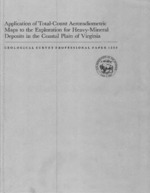Total-count contoured aeroradiometric maps for the Coastal Plain of Virginia were used in an effort to locate economic heavy-mineral placer deposits. The principle behind this approach is that heavy- mineral suites commonly contain radioactive minerals that, if the concentration of heavy minerals is exposed at or within inches of the surface, enable the deposit to be located by use of airborne instruments because of its radiometric contrast with the host sediment.
Detailed and regional geologic maps, soil maps, land-use and land- cover maps, information on fertilizer use, and ground-spectrometer data were used to study aeroradiometric anomalies for efficient exploration. Aeroradiometric anomalies in the Coastal Plain of Virginia have three general causes. First, the most intense anomalies are associated with cultural features, such as roads made of granitic material. Second, most anomalies of high to intermediate intensity are associated with land used for agricultural purposes and evidently are caused by applications of radioactive fertilizer. Third, anomalies of intermediate to low intensity are associated with heavy-mineral deposits.
Results of this study show that aeroradiometric anomalies associated with heavy-mineral accumulations in the Coastal Plain of Virginia have ground radiometric spectra in which thorium is the strongest component and uranium and potassium are lesser components.
Heavy-mineral accumulations found in this study by use of the aeroradiometric data are not considered to be of economic importance, mostly because of the low percentage of economic minerals in the heavy-mineral suites and also because of other factors such as the very fine grained nature of the host sediments and competing land use.


